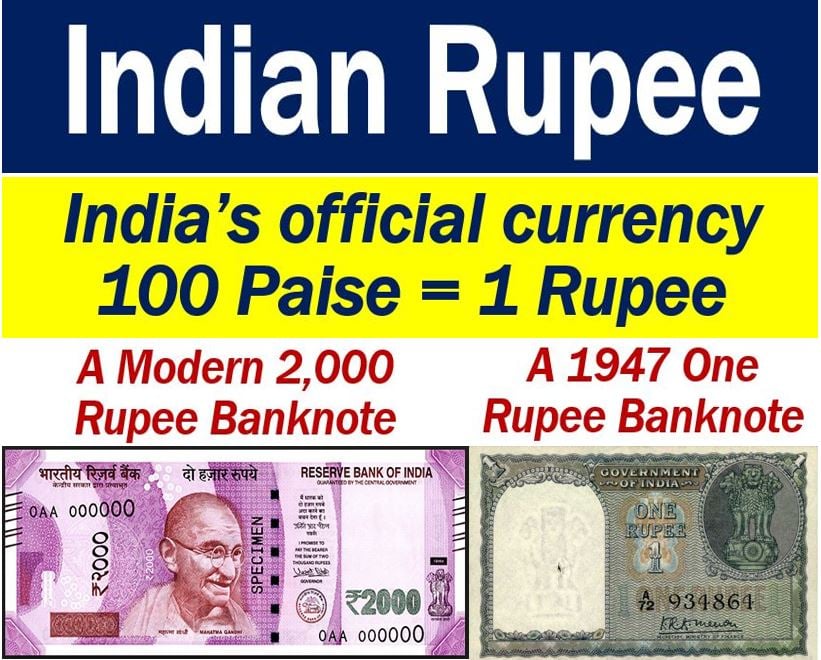Indian rupee – definition and history of the currency
The Indian Rupee – INR, Rs, or Rp – is the official currency unit of the Republic of India. One-hundred paise make up one rupee. The singular of paise is paisa. Therefore, one paisa is one-hundredth of one rupee.
Since 2011, there have been no coins worth 25 paise or less in India. The Reserve Bank of India, i.e., India’s central bank, controls the issuance of the country’s currency. A central bank is a financial institution that is in charge of a country’s currency and interest rates. It is also in charge of the money supply. We refer to central banks as the ‘bank of last resort.’
Some other countries, such as Pakistan and Bangladesh, also use the name rupee for their national currency. Indonesia, Maldives, Mauritius, Nepal, Bhutan, Seychelles, and Sri Lanka have rupees too.
The word was first used in the Indian subcontinent in 1610. It came from Urdu or Hindi Rupiyah, and Sanskrit Rypyah, which means ‘wrought silver.’ Maybe it was originally a coin with an image. The ancient word ‘Rupah’ meant ‘likeness, image, shape.’

Even though the Indian rupee has been a soft currency, things will probably change dramatically over the next twenty years. India is becoming a major economy in the world. Economists say that by the middle of this century, India will be among the world’s top three economies, alongside China and the United States.
A soft currency
In 1947, there were 3.30 Rs per US dollar. However, by the turn of the century, the Indian currency was worth considerably less. In the year 2000, there were 43 Rs per US$1.
Even since the turn of the century, India’s currency has continued to decline in value against the hard currencies. Today, one US dollar is worth about 65 Rs.
A soft currency is a currency that people trust less than a hard currency. The Russian ruble, Mexican peso, and Brazilian real are soft currencies. The US dollar, euro, pound and yen, on the other hand, are hard currencies.
Indian rupee – brief history
Indian rupees have been around in one form or another for a long time.
1540-1545
Sher Shah Suri issued a silver coin. He was the founder of the Sur Empire in the northern part of the Indian subcontinent.
The coins remained in use for hundreds of years. Even during the British India period, the coins were still in circulation.
1770-1832
The Bank of Hindostan issued the first paper rupees, i.e., banknotes. The General Bank of Bengal and Bihar and Bengal Bank also issued paper rupees in 1773-1775 and 1784-1791 respectively.
April 1st, 1935
The Reserve Bank of India was born.
1938
In January, India’s central bank issued the first five-rupee banknote.
From February to June, it issued the 10, 100, 1,000, and 10,000 rupee banknotes.
1950
The central bank issued the first post-independence coins.
1953
The central bank prominently displayed Hindi on the new notes.
1954
The central bank reintroduced high denomination notes, i.e., 1,000, 5,000, and 10,000 banknotes.
The plural of rupaya became rypiye.
1957
The Reserve Bank of India introduced decimalization. One rupee consisted of 100 naye paise.
1957-1967
The central bank introduced aluminium (American English: aluminum) coins, i.e., with one, two, three, five and ten paise denominations.
1967
The Reserve Bank of India reduced the size of notes due to the early sixties ‘lean period.’ The economy was not only poor, but things were also scarce.
1980
New notes with symbols of science and tech went into circulation. Also banknotes with images of agricultural mechanization, oil rigs, and Indian art forms were issued.
1987-1992
Five-hundred rupee notes went into circulation. The central bank also introduced stainless steel coins.
1996
The Reserve Bank of India introduced a series of notes with the image of Mahatma Gandhi.
2016
The central bank discontinued 500 and 1,000 rupee banknotes. It introduced new 500 and 2,000 banknotes.

